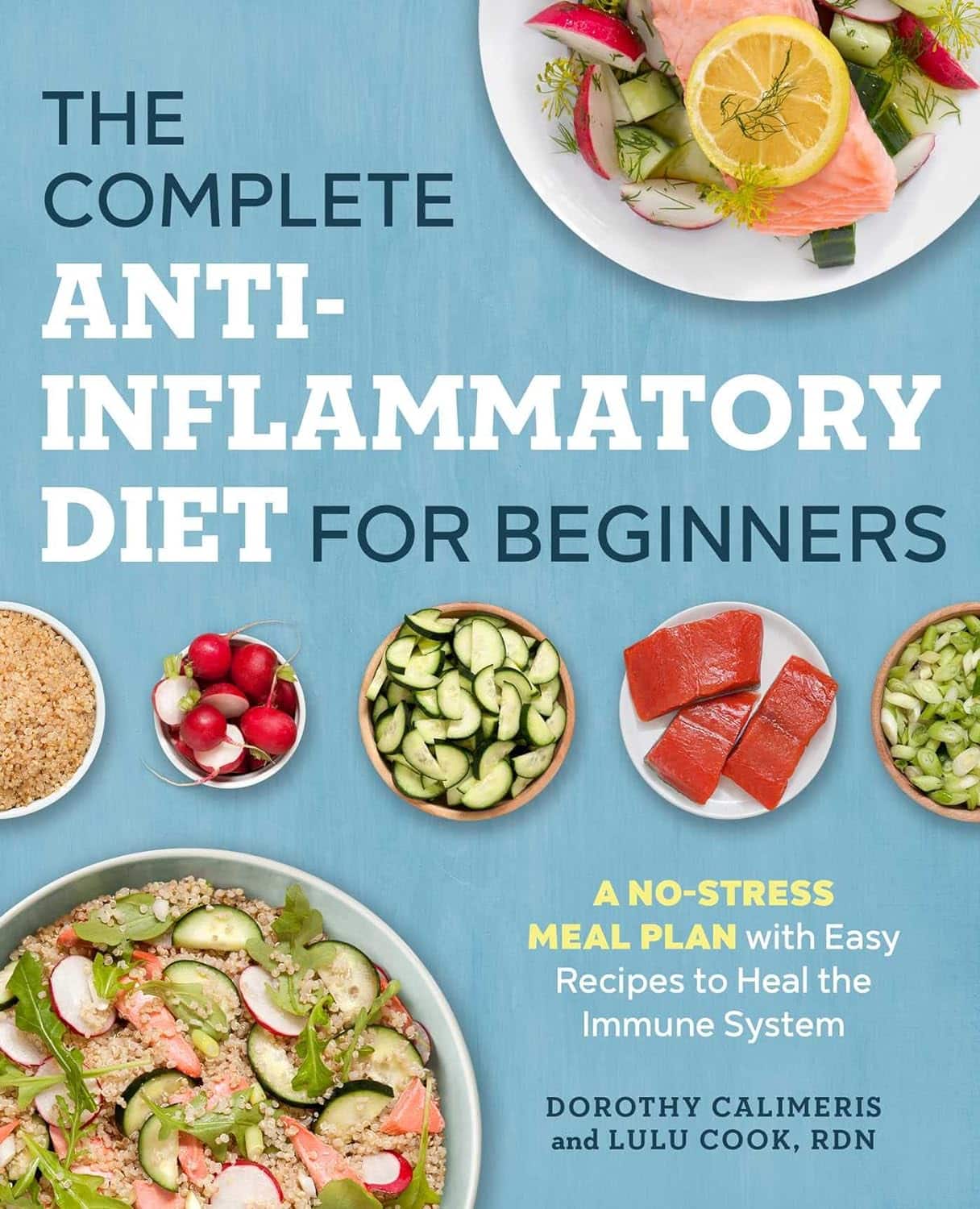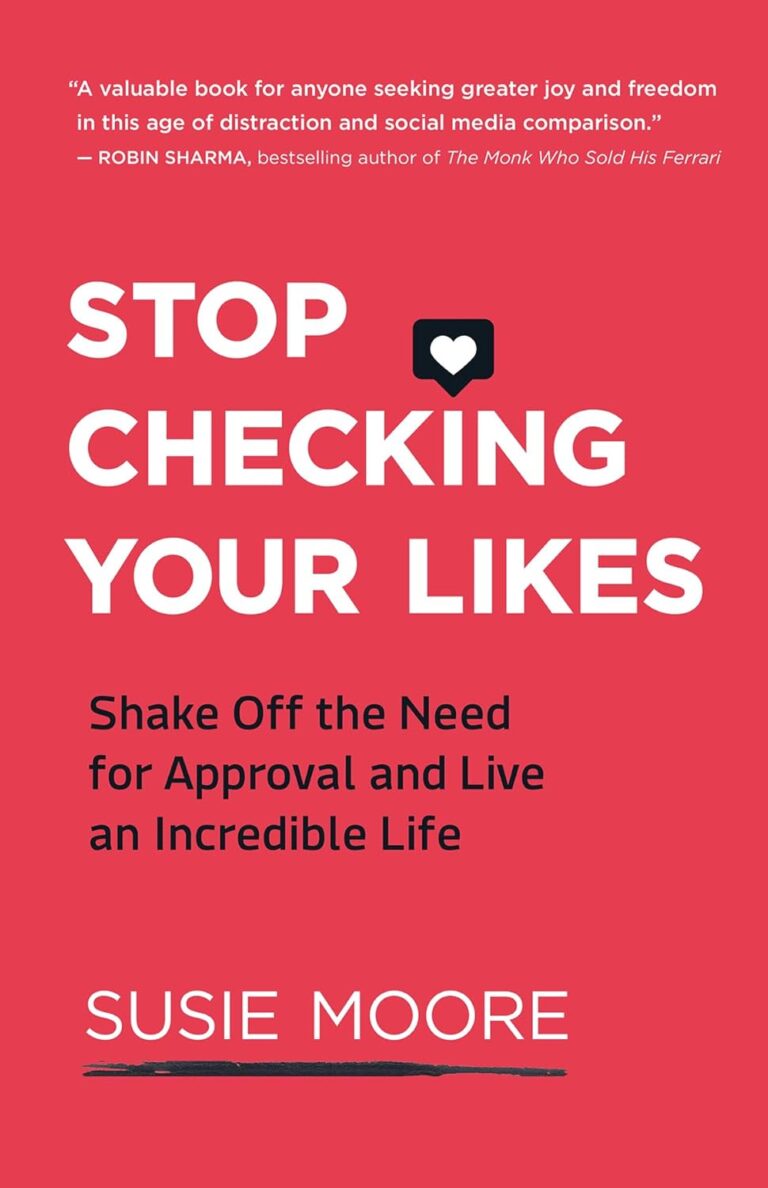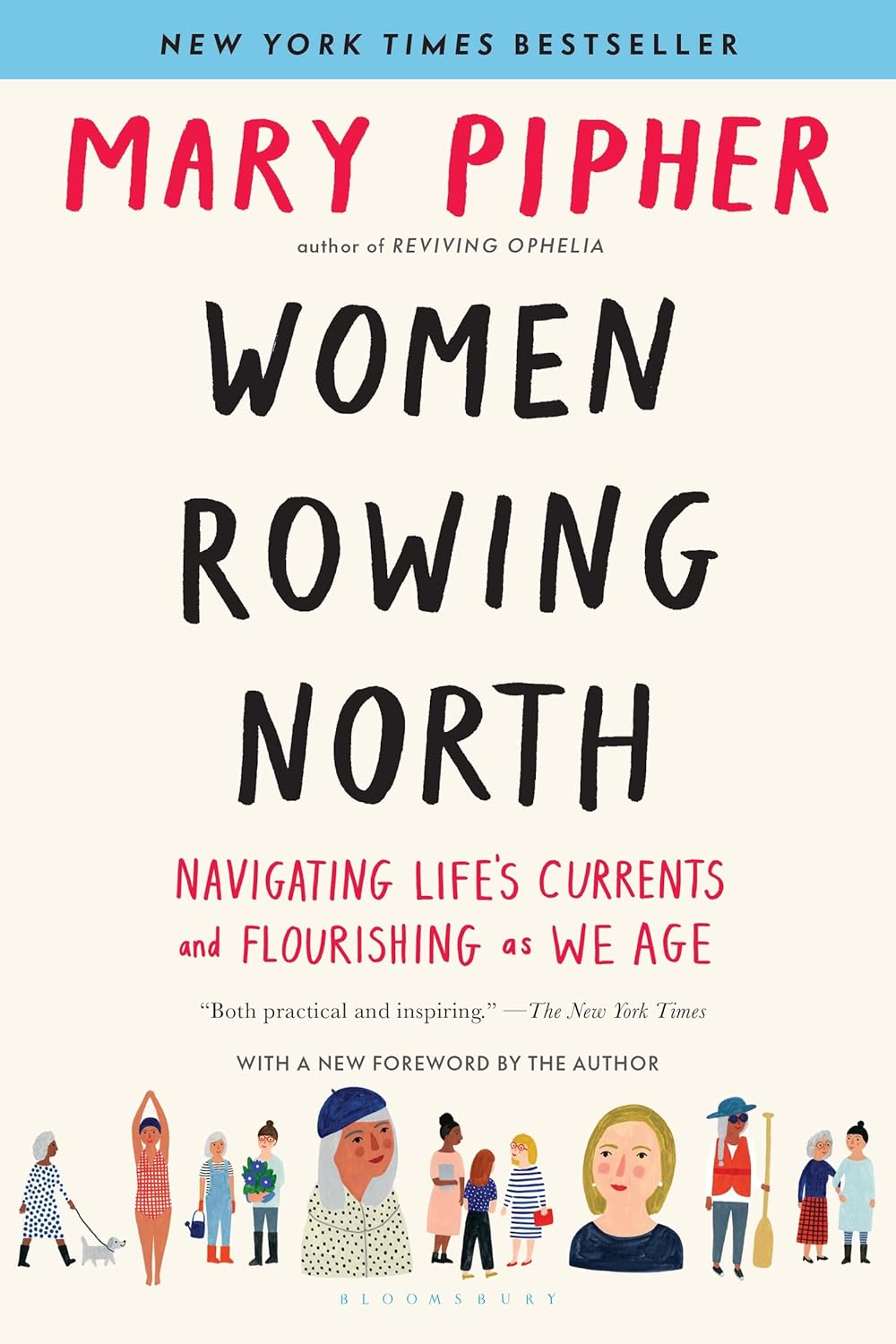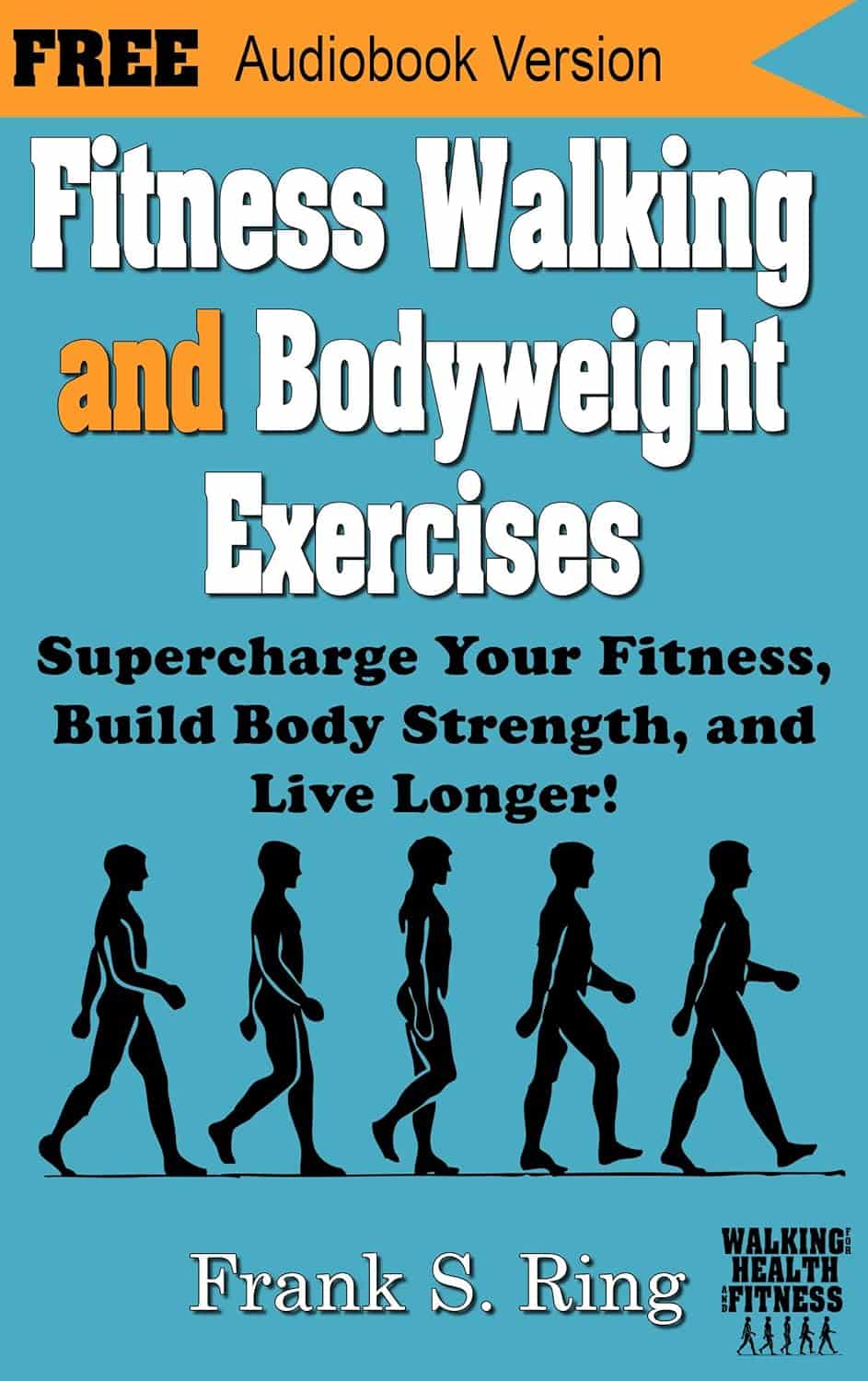
The Complete Anti-Inflammatory Diet for Beginners – by Dorothy Calimeris and Lulu Cook
10almonds is reader-supported. We may, at no cost to you, receive a portion of sales if you purchase a product through a link in this article.
First, about the authors: notwithstanding the names, Calimeris is the cook, and Cook is the nutritionist (and an RDN at that).
As for the book: we get a good primer on the science of inflammation, what it is, why it happens, what things are known to cause/trigger it, and what things are known to fight it. They do also go outside of nutrition a bit for this, speaking briefly on other lifestyle factors too, but the main focus is of course nutrition.
As for the recipes: while distinctly plants-forward (as one might expect of an anti-inflammatory eating book), it’s not outright vegan or even vegetarian, indeed, in the category of main dishes, there are sections for:
- Vegetarian and vegan
- Fish and shellfish
- Poultry and meat
…as well as, before and after those, sections for breakfast and brunch and snacks and sweets. As well as a not-to-be-underestimated section, for sauces, condiments, and dressings. This is important, because those are quite often the most inflammatory parts of an otherwise healthy meal! So being able to make anti-inflammatory versions is a real boon.
The recipes are mostly not illustrated, but the steps are very clearly described and easy to follow.
Bottom line: if inflammation is currently on your to-tackle list, this book will be an excellent companion in the kitchen.
Don’t Forget…
Did you arrive here from our newsletter? Don’t forget to return to the email to continue learning!
Recommended
Learn to Age Gracefully
Join the 98k+ American women taking control of their health & aging with our 100% free (and fun!) daily emails:

Here’s Looking At Ya!
10almonds is reader-supported. We may, at no cost to you, receive a portion of sales if you purchase a product through a link in this article.
This Main Feature Should Take You Two Minutes (and 18 Seconds) To Read*
*Or at least, that’s what we’re told by our powerful software that checks things for readability!
Curious what that looks like? Try Out Hemingway App Online Here!
There’s a problem nobody wants to talk about when it comes to speed-reading
If you’re not very conscientious in your method, information does get lost. Especially, anything over 500 words per minute is almost certainly skimming and not true speed-reading.
One of the reasons information gets lost is because of a weird and wonderful feature of our eyes and brain: saccades.
Basically, our eyes can either collect visual information or they can move; they can’t do both at once. And as you may know, our eyes are almost always moving. So why aren’t we blind most of the time?
We actually are.
Did you know: your eyes take two upside-down 2D images and your brain presents you one 3D image the right way around instead? You probably did know that. So: it’s a bit like that.
Your brain takes a series of snapshots from whenever your eyes weren’t moving, and mentally fills in the blanks for you, just like a studio animation. We have a “frame rate” of about 60 frames per second, by the way—that’s why many computer monitors use that frequency. Lower frequencies can result in a noticeable flicker, and higher frequencies are wasted on us mere mortals!
Our eyes do some super-speedy movements called saccades (up to 500º per second! Happily no, our eyes don’t rotate 500º, but that’s the “per second” rate) and our brain fills in the gaps with its best guesses. The more you push it, the more it’ll guess wrong.
We’re not making this up, by the way! See for yourself:
Eye Movements In Reading And Information Processing: 20 Years Of Research
Fortunately, it is possible to use your eyes in a way that reduces the brain’s need to guess. That also means it has more processing power left over to guess correctly when it does need to.
Yes, There’s An App For That
Actually there are a few! But we’re going to recommend Spreeder as a top-tier option, with very rapid improvement right from day one.
It works by presenting the text with a single unmoving focal point. This is the opposite of traditional speed-reading methods that involve a rapidly moving pacer (such as your finger on the page, or a dot on the screen).
This unmoving focal point (while the words move instead) greatly reduces the number of saccades needed, and so a lot less information is lost to optical illusions and guesswork.
Try Spreeder (any platform) Here Now!
If you find that easy to use and would like something with a few more features, you might like another app that works on the same principle: Spritz.
It can take a bit more getting-used-to, but allows for greater integrations with all your favourite content in the long-run:
Check Out Spritz: Android App / iOS App / Free Chrome Extension
Lastly, if you don’t want any of those fancy apps and would just like to read more quickly and easily with less eye-strain, Beeline has you covered.
For free, unless you want to unlock some premium features!
How Beeline works is by adding a color gradient to text on websites and in documents. This makes it a lot easier for the eye to track without going off-piste, skipping a line, or re-reading the same bit again, etc.
Share This Post

Women Rowing North – by Dr. Mary Pipher
10almonds is reader-supported. We may, at no cost to you, receive a portion of sales if you purchase a product through a link in this article.
Ageism is rife, as is misogyny. And those can be internalized too, and compounded as they intersect.
Clinical psychologist Dr. Mary Pipher, herself 75, writes for us a guidebook of, as the subtitle goes, “navigating life’s currents and flourishing as we age”.
The book does assume, by the way, that the reader is…
- a woman, and
- getting old (if not already old)
However, the lessons the book imparts are vital for women of any age, and valuable as a matter of insight and perspective for any reader.
Dr. Pipher takes us on a tour of aging as a woman, and what parts of it we can make our own, do things our way, and take what joy we can from it.
Nor is the book given to “toxic positivity” though—it also deals with themes of hardship, frustration, and loss.
When it comes to those elements, the book is… honest, human, and raw. But also, an exhortation to hope, beauty, and a carpe diem attitude.
Bottom line: this book is highly recommendable to anyone of any age; life is precious and can be short. And be we blessed with many long years, this book serves as a guide to making each one of them count.
Click here to check out Women Rowing North—it really is worth it
Share This Post

Is there anything good about menopause? Yep, here are 4 things to look forward to
10almonds is reader-supported. We may, at no cost to you, receive a portion of sales if you purchase a product through a link in this article.
Menopause is having a bit of a moment, with less stigma and more awareness about the changes it can bring.
A recent senate inquiry recommended public education about perimenopause and menopause, more affordable treatments and flexible work arrangements.
But like many things in life the experiences of menopause are on a continuum. While some women find it challenging and require support, others experience some physical and emotional benefits. These are rarely reported – but we can learn from the research available and, importantly, from people’s lived experiences.
Here are four changes to look forward to once you reach menopause.

Insta_Photos/Shutterstock 1. No more periods or related issues
Menopause is considered “complete” 12 months after the final period of a woman (or person assigned female at birth) who previously menstruated.
Perhaps unsurprisingly, the benefit at the top of the list is no more periods (unless you are taking hormone therapy and still have your womb). This can be particularly beneficial for women who have had to manage erratic, unpredictable and heavy bleeding.
At last, you don’t need to keep sanitary protection in every bag “just in case”. No more planning where the bathroom is or having to take extra clothes. And you’ll save money by not purchasing sanitary products.
There is also good news for women who have had heavy bleeding due to uterine fibroids – common benign gynaecological tumours that affect up to 80% of women. The evidence suggests hormonal changes (for women not taking hormone therapy) can lead to a reduction in the size of fibroids and relieve symptoms.
Women who suffer from menstrual migraine may experience an improvement in migraines post-menopause as their hormonal fluctuations begin to settle – but the timeframe for this remains unclear.
For some women, no more periods also means more participation in social activities from which they may have been excluded due to periods. For example, religious activities or food preparation in some cultures.
2. Getting your body and your groove back
Throughout their reproductive lives, women in heterosexual relationships are usually the ones expected to be proactive about preventing pregnancy.
Some post-menopausal women describe a re-emergence of their sexuality and a sense of sexual freedom that they had not previously experienced (despite contraceptive availability) as there is no longer a risk of pregnancy.
A participant in my research into women’s experiences of menopause described the joy of no longer being child-bearing age:
I’ve got a body back for me, you know, coz I can’t get pregnant, not that I haven’t enjoyed having [children] and things like that and it was a decision to get pregnant but I feel like, ooh my body isn’t for anybody now but me, people, you know?
For women who have chosen to be child-free there may also be a sense of freedom from social expectations. People will likely stop asking them when they are planning to have children.
3. A new chapter and a time to focus on yourself
Another participant described menopause as an unexpected “acceleration point” for change.
Women told us they were more accepting of themselves and their needs rather than being focused on the needs of other people. Researchers have previously tracked this shift from “living for others” to “a life of one’s own”.
Some women find the strength of emotions at this time a challenge, whereas others find their potency can facilitate liberation – enabling them to speak their minds or be more assertive than at any other time in their lives.
4. Increased self-confidence
A new sense of liberation can fuel increased self-confidence at menopause. This has been reported in studies based on in-depth interviews with women.
Confidence boosts can coincide with changes in career and sometimes in relationships as priorities and self-advocacy transform.
Life on the other side
It can be hard to think about what is good about menopause, particularly if you are having challenges during perimenopause – but these can get better with time.
In cultures where women are valued as they become older, women describe themselves as positively contributing to the community. They find they gain power and respect as they age.
We need to work towards more positive societal attitudes on this front. Our bodies change across the lifespan and are remarkable at every stage, including menopause.
Yvonne Middlewick, Nurse, Lecturer & Director of Post-graduate Studies in the School of Nursing and Midwifery, Edith Cowan University
This article is republished from The Conversation under a Creative Commons license. Read the original article.
Share This Post
Related Posts

Fitness Walking and Bodyweight Exercises – by Frank S. Ring
10almonds is reader-supported. We may, at no cost to you, receive a portion of sales if you purchase a product through a link in this article.
A lot of exercise manuals assume that the reader has a “basic” body (nothing Olympian, but nothing damaged either). As we get older, increasingly few of us fall into the “but nothing damaged either” category!
Here’s where Ring brings to bear his decades of experience as a coach and educator, and also his personal recovery from a serious back injury.
The book covers direct, actionable exercise advice (with all manner of detail), and also offers mental health tips he’s learned along the way.
Ring, like us, is a big fan of keeping things simple, so he focusses on “the core four” of bodyweight exercises:
- Pushups
- Squats
- Lunges
- Planks
These four exercises get a whole chapter devoted to them, though! Because there are ways to make each exercise easier or harder, or have different benefits. For example, adjustments include:
- Body angle
- Points of contact
- Speed
- Pausing
- Range of motion
This, in effect, makes a few square meters of floor (and perhaps a chair or bench) your fully-equipped gym.
As for walking? Ring enjoys and extols the health benefits, and/but also uses his walks a lot for assorted mental exercises, and recommends we try them too.
A fine book for anyone who wants to gain and/or maintain good health, but doesn’t pressingly want to join a gym or start pumping iron!
Don’t Forget…
Did you arrive here from our newsletter? Don’t forget to return to the email to continue learning!
Learn to Age Gracefully
Join the 98k+ American women taking control of their health & aging with our 100% free (and fun!) daily emails:

Can I take antihistamines everyday? More than the recommended dose? What if I’m pregnant? Here’s what the research says
10almonds is reader-supported. We may, at no cost to you, receive a portion of sales if you purchase a product through a link in this article.
Allergies happen when your immune system overreacts to a normally harmless substance like dust or pollen. Hay fever, hives and anaphylaxis are all types of allergic reactions.
Many of those affected reach quickly for antihistamines to treat mild to moderate allergies (though adrenaline, not antihistamines, should always be used to treat anaphylaxis).
If you’re using oral antihistamines very often, you might have wondered if it’s OK to keep relying on antihistamines to control symptoms of allergies. The good news is there’s no research evidence to suggest regular, long-term use of modern antihistamines is a problem.
But while they’re good at targeting the early symptoms of a mild to moderate allergic reaction (sneezing, for example), oral antihistamines aren’t as effective as steroid nose sprays for managing hay fever. This is because nasal steroid sprays target the underlying inflammation of hay fever, not just the symptoms.
Here are the top six antihistamines myths – busted.

Andrea Piacquadio/Pexels Myth 1. Oral antihistamines are the best way to control hay fever symptoms
Wrong. In fact, the recommended first line medical treatment for most patients with moderate to severe hay fever is intranasal steroids. This might include steroid nose sprays (ask your doctor or pharmacist if you’d like to know more).
Studies have shown intranasal steroids relieve hay fever symptoms better than antihistamine tablets or syrups.
To be effective, nasal steroids need to be used regularly, and importantly, with the correct technique.
In Australia, you can buy intranasal steroids without a doctor’s script at your pharmacy. They work well to relieve a blocked nose and itchy, watery eyes, as well as improve chronic nasal blockage (however, antihistamine tablets or syrups do not improve chronic nasal blockage).
Some newer nose sprays contain both steroids and antihistamines. These can provide more rapid and comprehensive relief from hay fever symptoms than just oral antihistamines or intranasal steroids alone. But patients need to keep using them regularly for between two and four weeks to yield the maximum effect.
For people with seasonal allergic rhinitis (hayfever), it may be best to start using intranasal steroids a few weeks before the pollen season in your regions hits. Taking an antihistamine tablet as well can help.
Antihistamine eye drops work better than oral antihistamines to relieve acutely itchy eyes (allergic conjunctivitis).
Myth 2. My body will ‘get used to’ antihistamines
Some believe this myth so strongly they may switch antihistamines. But there’s no scientific reason to swap antihistamines if the one you’re using is working for you. Studies show antihistamines continue to work even after six months of sustained use.
Myth 3. Long-term antihistamine use is dangerous
There are two main types of antihistamines – first-generation and second-generation.
First-generation antihistamines, such as chlorphenamine or promethazine, are short-acting. Side effects include drowsiness, dry mouth and blurred vision. You shouldn’t drive or operate machinery if you are taking them, or mix them with alcohol or other medications.
Most doctors no longer recommend first-generation antihistamines. The risks outweigh the benefits.
The newer second-generation antihistamines, such as cetirizine, fexofenadine, or loratadine, have been extensively studied in clinical trials. They are generally non-sedating and have very few side effects. Interactions with other medications appear to be uncommon and they don’t interact badly with alcohol. They are longer acting, so can be taken once a day.
Although rare, some side effects (such as photosensitivity or stomach upset) can happen. At higher doses, cetirizine can make some people feel drowsy. However, research conducted over a period of six months showed taking second-generation antihistamines is safe and effective. Talk to your doctor or pharmacist if you’re concerned.

Allergies can make it hard to focus. Pexels/Edward Jenner Myth 4. Antihistamines aren’t safe for children or pregnant people
As long as it’s the second-generation antihistamine, it’s fine. You can buy child versions of second-generation antihistamines as syrups for kids under 12.
Though still used, some studies have shown certain first-generation antihistamines can impair childrens’ ability to learn and retain information.
Studies on second-generation antihistamines for children have found them to be safer and better than the first-generation drugs. They may even improve academic performance (perhaps by allowing kids who would otherwise be distracted by their allergy symptoms to focus). There’s no good evidence they stop working in children, even after long-term use.
For all these reasons, doctors say it’s better for children to use second-generation than first-generation antihistimines.
What about using antihistimines while you’re pregnant? One meta analysis of combined study data including over 200,000 women found no increase in fetal abnormalities.
Many doctors recommend the second-generation antihistamines loratadine or cetirizine for pregnant people. They have not been associated with any adverse pregnancy outcomes. Both can be used during breastfeeding, too.
Myth 5. It is unsafe to use higher than the recommended dose of antihistamines
Higher than standard doses of antihistamines can be safely used over extended periods of time for adults, if required.
But speak to your doctor first. These higher doses are generally recommended for a skin condition called chronic urticaria (a kind of chronic hives).
Myth 6. You can use antihistamines instead of adrenaline for anaphylaxis
No. Adrenaline (delivered via an epipen, for example) is always the first choice. Antihistamines don’t work fast enough, nor address all the problems caused by anaphylaxis.
Antihistamines may be used later on to calm any hives and itching, once the very serious and acute phase of anaphylaxis has been resolved.
In general, oral antihistamines are not the best treatment to control hay fever – you’re better off with steroid nose sprays. That said, second-generation oral antihistamines can be used to treat mild to moderate allergy symptoms safely on a regular basis over the long term.
Janet Davies, Respiratory Allergy Stream Co-chair, National Allergy Centre of Excellence; Professor and Head, Allergy Research Group, Queensland University of Technology; Connie Katelaris, Professor of Immunology and Allergy, Western Sydney University, and Joy Lee, Respiratory Allergy Stream member, National Allergy Centre of Excellence; Associate Professor, School of Public Health and Preventive Medicine, Monash University
This article is republished from The Conversation under a Creative Commons license. Read the original article.
Don’t Forget…
Did you arrive here from our newsletter? Don’t forget to return to the email to continue learning!
Learn to Age Gracefully
Join the 98k+ American women taking control of their health & aging with our 100% free (and fun!) daily emails:

There are ‘forever chemicals’ in our drinking water. Should standards change to protect our health?
10almonds is reader-supported. We may, at no cost to you, receive a portion of sales if you purchase a product through a link in this article.
Today’s news coverage reports potentially unsafe levels of “forever chemicals” detected in drinking water supplies around Australia. These include human-made chemicals: perfluorooctane sulfonate (known as PFOS) and perflurooctanic acid (PFOA). They are classed under the broader category of per- and polyfluoroalkyl substances or PFAS chemicals.
The contaminants found in our drinking water are the same ones United States authorities warn can cause cancer over a long period of time, with reports warning there is “no safe level of exposure”.
In April, the US Environmental Protection Agency (USEPA) sent shock waves through the water industry around the world when it announced stricter advice on safe levels of PFOS/PFOA in drinking water. This reduced limits considered safe in supplies to zero and gave the water industry five years to meet legally enforceable limits of 4 parts per trillion.
So, should the same limits be enforced here in Australia? And how worried should we be that the drinking in many parts of Australia would fail the new US standards?
What are the health risks?
Medical knowledge about the human health effects of PFOS/PFOA is still emerging. An important factor is the bioaccumulation of these chemicals in different organs in the body over time.
Increased exposure of people to these chemicals has been associated with several adverse health effects. These include higher cholesterol, lower birth weights, modified immune responses, kidney and testicular cancer.
It has been very difficult to accurately track and measure effects of different levels of PFAS exposure on people. People may be exposed to PFAS chemicals in their everyday life through waterproofing of clothes, non-stick cookware coatings or through food and drinking water. PFAS can also be in pesticides, paints and cosmetics.
The International Agency for Research on Cancer (on behalf of the World Health Organization) regards PFOA as being carcinogenic to humans and PFOS as possibly carcinogenic to humans.

Is our drinking water safe? What about long-term risks? Volodymyr TVERDOKHLIB/Shutterstock Our guidelines
Australian drinking water supplies are assessed against national water quality standards. These Australian Drinking Water Guidelines are continuously reviewed by industry and health experts that scan the international literature and update them accordingly.
All city and town water supplies across Australia are subject to a wide range of physical and chemical water tests. The results are compared to Australian water guidelines.
Some tests relate to human health considerations, such as levels of lead or bacteria. Others relate to “aesthetic” considerations, such as the appearance or taste of water. Most water authorities across Australia make water quality information and compliance with Australian guidelines freely available.
What about Australian PFOS and PFOA standards?
These chemicals can enter our drinking water system from many potential sources, such as via their use in fire-fighting foams or pesticides.
According to the Australian Drinking Water Guidelines, PFOS should not exceed 0.07 micrograms per litre in drinking water. And PFOA should not exceed 0.56 micrograms per litre. One microgram is equivalent to one part per billion.
The concentration of these chemicals in water is incredibly small. And much of the advice on their concentration is provided in different units. Sometimes in micrograms or nannograms. The USEPA uses parts per trillion.
In parts per trillion (ppt) the Australian Guidelines for PFOS is 70 ppt and PFOA is 560 ppt. The USEPA’s new maximum contaminant levels (enforceable levels) are 4 ppt for both PFOS and also PFOA. Previous news reports have pointed out Australian guidelines for these chemicals in drinking water are up to 140 times higher than the USEPA permits.
Yikes! That seems like a lot
Today’s news report cites PFOS and PFOA water tests done at many different water supplies across Australia. Some water samples did not detect either chemicals. But most did, with the highest PFOS concentration 15.1–15.6 parts per trillion from Glenunga, South Australia. The highest PFOA concentration was reported from a small water supply in western Sydney, where it was detected at 5.17–9.66 parts per trillion.
Australia and the US are not alone. This is an enormous global problem.
One of the obvious challenges for the Australian water industry is that current water treatment processes may not be effective at removing PFOS or PFOA. The Australian Drinking Water Guidelines provide this advice:
Standard water treatment technologies including coagulation followed by physical separation, aeration, chemical oxidation, UV irradiation, and disinfection have little or no effect on PFOS or PFOA concentrations.
Filtering with activated carbon and reverse osmosis may remove many PFAS chemicals. But no treatment systems appear to be completely effective at their removal.
Removing these contaminants might be particularly difficult for small regional water supplies already struggling to maintain their water infrastructure. The NSW Auditor General criticised the planning for, and funding of, town water infrastructure in regional NSW back in 2020.
Where to from here?
The Australian water industry likely has little choice but to follow the US lead and address PFOS/PFAS contamination in drinking water. Along with lower thresholds, the US committed US$1 billion to water infrastructure to improve detection and water treatment. They will also now require:
Public water systems must monitor for these PFAS and have three years to complete initial monitoring (by 2027) […]
As today’s report notes, it is very difficult to find any recent data on PFOS and PFOA in Australian drinking water supplies. Australian regulators should also require ongoing and widespread monitoring of our major city and regional water supplies for these “forever chemicals”.
The bottom line for drinking tap water is to keep watching this space. Buying bottled water might not be effective (2021 US research detected PFAS in 39 out of 100 bottled waters). The USEPA suggests people can reduce PFAS exposure with measures including avoiding fish from contaminated waters and considering home filtration systems.
Correction: this article previously listed the maximum Australian Drinking Water Guidelines PFOA level as 0.056 micrograms per litre. The figure has been updated to show the correct level of 0.56 micrograms per litre.
Ian A. Wright, Associate Professor in Environmental Science, Western Sydney University
This article is republished from The Conversation under a Creative Commons license. Read the original article.
Don’t Forget…
Did you arrive here from our newsletter? Don’t forget to return to the email to continue learning!
Learn to Age Gracefully
Join the 98k+ American women taking control of their health & aging with our 100% free (and fun!) daily emails:











